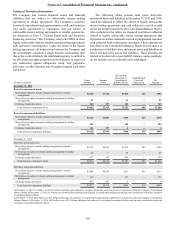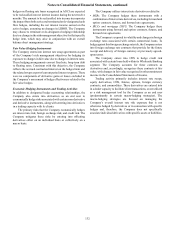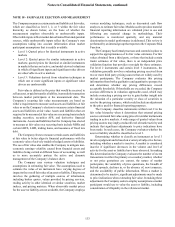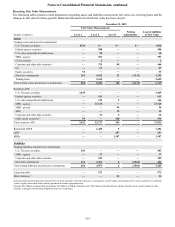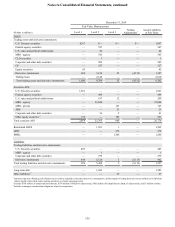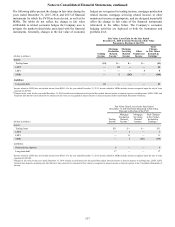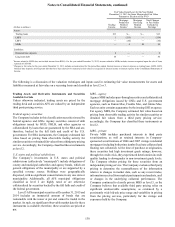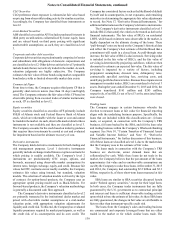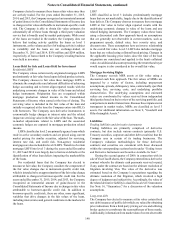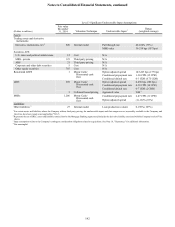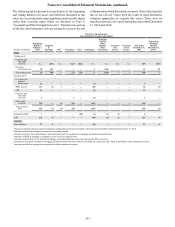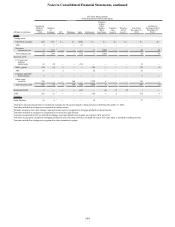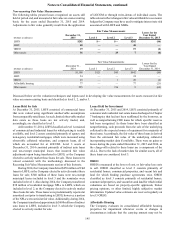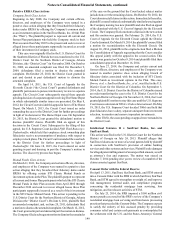SunTrust 2015 Annual Report Download - page 168
Download and view the complete annual report
Please find page 168 of the 2015 SunTrust annual report below. You can navigate through the pages in the report by either clicking on the pages listed below, or by using the keyword search tool below to find specific information within the annual report.Notes to Consolidated Financial Statements, continued
140
Company elected to measure these loans at fair value since they
are actively traded. For the years ended December 31, 2015,
2014, and 2013, the Company recognized an immaterial amount
of gains/(losses) in the Consolidated Statements of Income due
to changes in fair value attributable to instrument-specific credit
risk. The Company is able to obtain fair value estimates for
substantially all of these loans through a third party valuation
service that is broadly used by market participants. While most
of the loans are traded in the market, the Company does not
believe that trading activity qualifies the loans as level 1
instruments, as the volume and level of trading activity is subject
to variability and the loans are not exchange-traded. At
December 31, 2015 and 2014, $356 million and $284 million,
respectively, of loans related to the Company’s trading business
were held in inventory.
Loans Held for Sale and Loans Held for Investment
Residential LHFS
The Company values certain newly-originated mortgage LHFS
predominantly at fair value based upon defined product criteria.
The Company chooses to fair value these mortgage LHFS to
eliminate the complexities and inherent difficulties of achieving
hedge accounting and to better align reported results with the
underlying economic changes in value of the loans and related
hedge instruments. Origination fees are recognized within
mortgage production related income in the Consolidated
Statements of Income when earned at the time of closing. The
servicing value is included in the fair value of the loan and
initially recognized at the time the Company enters into IRLCs
with borrowers. The Company uses derivative instruments to
economically hedge changes in interest rates and the related
impact on servicing value in the fair value of the loan. The mark-
to-market adjustments related to LHFS and the associated
economic hedges are captured in mortgage production related
income.
LHFS classified as level 2 are primarily agency loans which
trade in active secondary markets and are priced using current
market pricing for similar securities, adjusted for servicing,
interest rate risk, and credit risk. Non-agency residential
mortgages are also included in level 2 LHFS. Transfers of certain
mortgage LHFS into level 3 during the years ended December
31, 2015 and 2014 were largely due to borrower defaults or the
identification of other loan defects impacting the marketability
of the loans.
For residential loans that the Company has elected to
measure at fair value, the Company considers the component of
the fair value changes due to instrument-specific credit risk,
which is intended to be an approximation of the fair value change
attributable to changes in borrower-specific credit risk. For the
years ended December 31, 2015, 2014, and 2013, the Company
recognized an immaterial amount of gains/(losses) in the
Consolidated Statements of Income due to changes in fair value
attributable to borrower-specific credit risk. In addition to
borrower-specific credit risk, there are other, more significant,
variables that drive changes in the fair values of the loans,
including interest rates and general conditions in the markets for
the loans.
LHFI
LHFI classified as level 3 includes predominantly mortgage
loans that are not marketable, largely due to the identification of
loan defects. The Company chooses to measure these mortgage
LHFI at fair value to better align reported results with the
underlying economic changes in value of the loans and any
related hedging instruments. The Company values these loans
using a discounted cash flow approach based on assumptions
that are generally not observable in current markets, such as
prepayment speeds, default rates, loss severity rates, and
discount rates. These assumptions have an inverse relationship
to the overall fair value. Level 3 LHFI also includes mortgage
loans that are valued using collateral based pricing. Changes in
the applicable housing price index since the time of the loan
origination are considered and applied to the loan's collateral
value. An additional discount representing the return that a buyer
would require is also considered in the overall fair value.
Mortgage Servicing Rights
The Company records MSR assets at fair value using a
discounted cash flow approach. The fair values of MSRs are
impacted by a variety of factors, including prepayment
assumptions, spreads, delinquency rates, contractually specified
servicing fees, servicing costs, and underlying portfolio
characteristics. The underlying assumptions and estimated
values are corroborated by values received from independent
third parties based on their review of the servicing portfolio, and
comparisons to market transactions. Because these inputs are not
transparent in market trades, MSRs are classified as level 3
assets. For additional information see Note 9, "Goodwill and
Other Intangible Assets."
Liabilities
Trading liabilities and derivative instruments
Trading liabilities are primarily comprised of derivative
contracts, but also include various contracts (primarily U.S.
Treasury securities, corporate and other debt securities) that the
Company uses in certain of its trading businesses. The
Company's valuation methodologies for these derivative
contracts and securities are consistent with those discussed
within the corresponding sections herein under “Trading Assets
and Derivative Instruments and Securities Available for Sale.”
During the second quarter of 2009, in connection with its
sale of Visa Class B shares, the Company entered into a derivative
contract whereby the ultimate cash payments received or paid,
if any, under the contract are based on the ultimate resolution of
litigation involving Visa. The value of the derivative was
estimated based on the Company’s expectations regarding the
ultimate resolution of that litigation, which involved a high
degree of judgment and subjectivity. Accordingly, the value of
the related derivative liability is classified as a level 3 instrument.
See Note 16, "Guarantees," for a discussion of the valuation
assumptions.
Long-term debt
The Company has elected to measure at fair value certain fixed
rate debt issuances of public debt which are valued by obtaining
price indications from a third party pricing service and utilizing
broker quotes to corroborate the reasonableness of those marks.
Additionally, information from market data of recent observable


